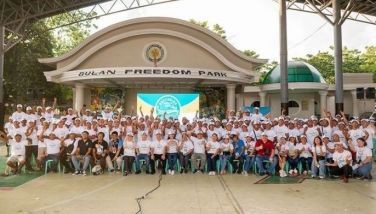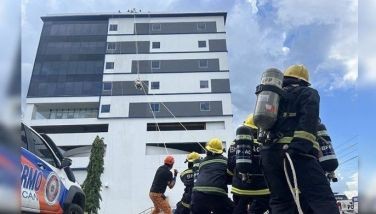Alejandrino day in Arayat

I am generally a cynic. I do not believe in coincidences or the reasons why they happen. But recently I experienced coincidences that have forced me to accept that these did happen and I have no way of explaining why they did.
Originally, the name I wanted for a crowdsourcing movement following the Icelandic model for constitution making was angbagongpilipinas.
I had friends who introduced me to their techie friends who would help me create the website page as well as design a logo. Unfortunately, this enterprise was dogged with failure.
Luckily, I decided to hold a meeting with the young techies to tell them that the design and layout of the page were not acceptable. Out of the blue, I received a phone call from Nick Lizaso, the celebrated film and theater director. He sat on the CCP board when I was there. He said he had attended the Club Filipino organizational meeting with CJ Reynato Puno as guest speaker, but he had not heard any developments since so he decided to see me.
He kept quiet listening intently to the discussion on the crowdsourcing website. He had only one suggestion: change the name. And what should it be? I asked. He said Bayan Ko. At the time he was thinking of the Tagalog version of Constancio de Guzman that became the theme song of the Edsa Revolution. If we were to have a launch date he suggested ways on how we could dramatize the song of protest. Although I agreed to change the name of the crowdsourcing website to Bayan Ko, I did my own research about the song.
I found out that the original song was written in Spanish by General Jose Alejandrino and that he specifically uses the word anglosajon. It was a song he created during the Philippine War of Independence against the Americans. So there was more to it than meets the eye.
In a discussion in Facebook, I posted the Spanish version and found it strange that the word anglosajon should have been omitted in the English and Tagalog versions.
Although I followed Nick Lizaso’s suggestion to use Bayan Ko I chose the Spanish version. Nick told me that he was surprised to know that the original version was written in Spanish and that it was written by Gen. Jose Alejandrino who was a hero of both the revolution against Spain, and then again in the war against the Americans. Are you sure about this, he asked. I was sure and so we changed the name from angbagongpilipinas to bayanko after the song written by Gen. Alejandrino. As I explained to those who became members of the movement, they must distinguish between the song and the movement. The song inspired the movement for crowdsourcing. It is about including all Filipinos in constitution making. The story does not stop there.
I was to find out later that Gen. Alejandrino was from Arayat and that he came from a family of revolutionaries. I read a little of its history and thought that one day I would visit this place that is said to have produced 10 revolutionary heroes in the space of 50 years. At that time I did not know any Alejandrino. At the time it was just a name that evoked a romanticized love of country.
Bayanko was launched in July 2013 at Club Filipino. It has gone from strength to strength because it was non-partisan. It was to be a vehicle for crowd participation, meaning, as they did in Iceland , it would fulfill the objective of how ordinary people — all the people — should take part in constitution making. Unfortunately, some political partisans would not want such a political principle of empowering the people to succeed. It was the class war again.
Such a principle would not be allowed to succeed. I found my answer in Arayat, a little municipality in Pampanga by the foot of the Arayat mountain. I was invited to come and attend Alejandrino day last December. This was the birthplace of notable revolutionaries, chief among them Gen. Jose Alejandrino and the Huk leader, Casto Alejandrino.
According to Wikipedia, “The Hukbalahap movement has deep roots in the Spanish encomienda, a system of grants to reward soldiers who had conquered New Spain, established about 1570. This developed into a system of exploitation. In the 19th century, Filipino landlordism, under the Spanish colonization, arose and, with it, further abuses. Only after the coming of the Americans were reforms initiated to lessen tensions between tenants and landlords. The reforms, however, did not solve the problems and, with growing political consciousness produced by education, peasants began to unite under educated but poor leaders. The most potent of these organizations was the Hukbalahap, which began as a resistance organization against the Japanese but ended as an anti-government resistance movement.”
In a column I wrote that Arayat was my Ithaca. It may have been a perilous journey but I made it to return to the fundamental problem that all Filipinos must be concerned with – and that is the making of a more equal playing field between the rich and the poor of this country. That objective can only be possible with constitutional reform which is what Bayanko is all about.
As I said good-bye after a whole day trip talking to the Alejandrinos and the people of Arayat who honored Gen. Jose Alejandrino y Magdangal as a revolutionary, I realized what my journey was all about. Mayor Emmanuel “Bon” Alejandrino was on his way out of his office, donning a jacket to confront the loggers who would destroy the national park that he has painstakingly revived even with little funds from the national government. He said, there were many things to do for the people of Arayat but they did not have the money and they would not expect it from the national government.
With a 60-40 division of the IRA with a lion’s share for the national government, they simply had to struggle. Indeed like most local officials the IRA was the battle of contention. By the time they receive their portion it would have been whittled by corrupt bureaucracy and they would be lucky if they even get 30% of what was due to them.
Arayat would be the beneficiary of constitutional reform to adopt federalism. Mayor Boon Alejandrino had fought many battles, with 40 years in the underground until his election by the people to serve them once again. He is hopeful that he will be able to surmount the difficulties, He asked for help from this column to make their plea heard. Come to Arayat and see what a good public official would do given the chance under a new system of politics and government
By the way, Mayor Boon Alejandrino is a direct descendant of Casto Alejandrino, the Huk leader. Mayor Bon Alejandrino counts as the 11th in the line of heroic ancestry. He wants to follow the tradition of his ancestors and leave a legacy. That is his last wish in life. Bayanko wishes him well.
- Latest
- Trending





























